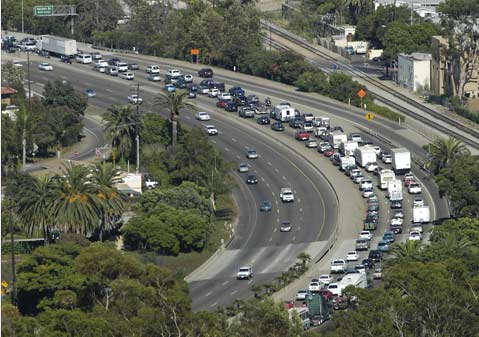Addressing Highway 101 Traffic Woes
Caltrans Plans High-Occupancy Vehicle Lanes Through South Coast

Caltrans wants to add high-occupancy vehicle lanes to Highway 101 on the South Coast, and held public meetings this week in furtherance of that goal. With an estimated cost of $425 million and construction anticipated to begin in 2014, the proposed project would add two part-time HOV lanes-one northbound and one southbound-between Carpinteria and Santa Barbara as the fourth phase of agency’s 101 Widening Strategy.
Representatives from Caltrans were on hand at two meetings, held July 7 and July 8, to present the Highway 101 South Coast High Occupancy Vehicle (HOV) Project to the public and take questions. An abundance of displays covered multiple aspects of the construction project. The meeting – part of the “public scoping” phase – served to “gather comments from the public on the environmental scope of the project,” according to project manager Scott Eades.
The first phase of construction is to be the addition of northbound and southbound lanes between Milpas Street and Cabrillo Boulevard – including the improvement of local roads and bicycle and pedestrian paths – and is scheduled for completion in 2012 with a budget of $53 million. The second phase is the addition of HOV lanes between Mussel Shoals and Carpinteria, which is anticipated to begin construction in 2011 and has an estimated cost of $132 million. Third is reconstruction of the Linden and Casitas Pass interchanges – including the replacement of the Carpinteria Creek Bridge and the extension of Via Real-with an estimated cost of $70 million, and construction anticipated to begin in 2013.
The objectives of the HOV-lanes strategy are to reduce peak-hour congestion, encourage carpooling and use of public transportation, and minimize the diversion of freeway traffic onto local roadways. According to the 101 In Motion project – a collaboration among the cities of Goleta, Santa Barbara, and Carpinteria, the County of Santa Barbara, the Air Pollution Control District, Caltrans, and Santa Barbara County Association of Governments (SBCAG)-research suggests that “without improvements traffic congestion is expected to increase to 10 hours a day by 2030.”
Currently, congestion occurs for two to four hours daily. Since congestion occurs when the number of vehicles exceeds the road’s capacity, and studies show that the number of vehicles on the 101 will increase with time, adding the part-time HOV lane would only solve the problem temporarily. Which is why 101 In Motion proposes a package of solutions rather than just one.
Along with the construction of HOV lanes between Santa Barbara and Carpinteria, 101 In Motion proposes: operating commuter rail on the existing railroad line between Camarillo and Goleta, with stops in Carpinteria and Santa Barbara; increasing express bus services within the county; offering incentives to encourage carpooling and trip reduction; rethinking local bus routes and light systems to prioritize commuter buses; varying parking rates to lower prices for vehicles arriving outside of peak hours; working to alleviate freeway traffic north of Milpas Street by monitoring needs and options; and improving overall operations and communications to make travelers and roads “more intelligent in terms of information.” The overall effectiveness of the package has been broken down into categories, with HOV lanes accounting for 64 percent of the package’s effectiveness and rail implementation accounting for 18 percent.
The final cost of this comprehensive plan is $833 million. Its funding relies heavily on the renewal of the Measure D transportation sales tax. However, the South Coast HOV Project alone would only cost $425 million, with $140 million already secured through Measure A regional sales tax renewal funds and additional funding anticipated from SBCAG’s Regional Transportation Improvement Program (RTIP). Although this leaves a $285 million gap, Caltrans’s Jim Shivers said that the commitment of $140 million dollars puts the program in a strong position to leverage funding from state and federal sources.
Following the presentation, a few locals expressed concerns about the left-hand Cabrillo Boulevard and Sheffield Road exits, which would likely conflict with the HOV lanes. Although the presenters did not have any concrete answers – no decisions had been made concerning precisely where the lanes would begin and end – they did present the possibility of reconfiguring these exits to allow for the HOV lanes. Other attendees were concerned with how the aesthetic quality of the 101 may be compromised with reduced vegetation or even just a single concrete divider. According to some attendees the divider would be “unsafe and unattractive,” and one resident argued that it would reduce visibility at night due to oncoming headlight glare. This problem was left unresolved.
The project is not expected to require the acquisition of any private property, as construction is anticipated to remain inside the right-of-way the 101 already inhabits. According to Caltrans representative Larry Newland, attendees at the Tuesday, July 7 meeting in Carpinteria expressed concerns that the project would encourage Santa Barbara workers to commute, allowing them “to get a bigger house farther away from Santa Barbara.” Although this may be true, Newland said, the project addresses the issues of a statewide highway-with its freight-haulers, long-distance travelers, and service vehicles – as well as those of a local highway.
Caltrans is encouraging the community to respond with comments and concerns. Mail letters to Matt Fowler, Environmental Analysis Chief, Caltrans, 50 Higuera Street, San Luis Obispo, CA 93401, or email to matt_c_fowler@dot.ca.gov. For more information, visit the 101 In Motion Web site or contact Project Manager Scott Eades of Caltrans at (805) 549-3144.



